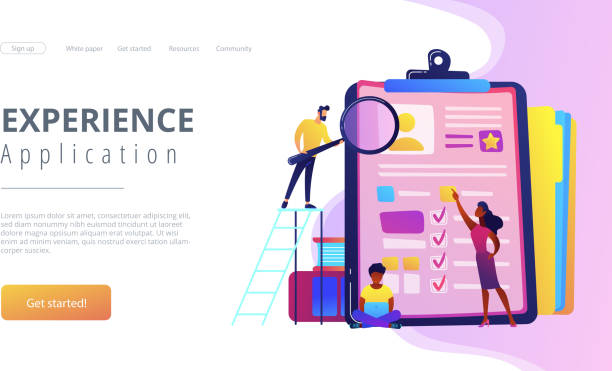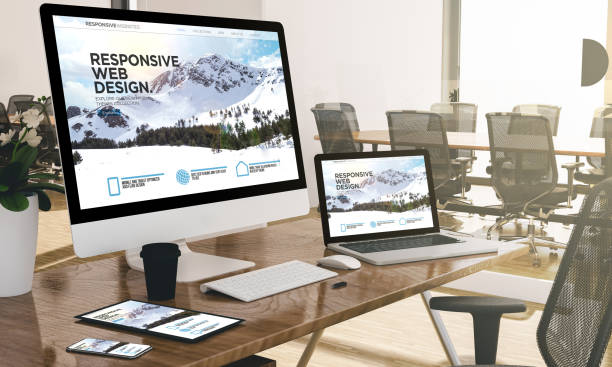Introduction to Responsive Web Design: What is it?

In today’s world, where various devices with different screen dimensions are used to access the internet, the concept of #Responsive_Web_Design has become more important than ever.
This web design approach means that a website can automatically and intelligently adjust its layout and elements to the size and orientation of the user’s device screen, whether that device is a large desktop computer, a laptop, a tablet, or a smartphone.
The main goal of #Responsive_Design is to provide a seamless and optimal user experience for all users, regardless of the device they are using.
This is particularly crucial in an era where mobile users constitute a significant percentage of web traffic.
Without responsive web design, users would be forced to zoom or scroll horizontally to view content on smaller screens, which is an unpleasant experience.
This explanatory section is the first step in understanding why this technology is important.
Did you know that a weak corporate website takes away many opportunities from you daily? Solve this problem forever with professional corporate website design by Rasav!
✅ Create a powerful and reliable image of your brand
✅ Attract targeted new customers and increase sales
⚡ [Get free website design consultation]
Fundamental Principles and Techniques of Responsive Design

To effectively implement responsive design, there are three key principles: Media Queries, Fluid Grids, and Flexible Images.
Media queries allow developers to apply different CSS rules based on device characteristics such as screen width, height, orientation, and resolution.
This tool enables the website to change its appearance based on the user’s screen size.
Fluid grids use relative units like percentages for element widths instead of fixed pixel units.
This approach ensures that the website’s layout expands or contracts with screen size changes, optimizing the available space.
Flexible images, using properties like `max-width: 100%` in CSS, ensure that images do not overflow their containers and scale appropriately to the available space.
The combination of these three techniques forms the main foundation for creating a powerful and efficient responsive web design.
This specialized section provides the technical details needed to get started.
Multiple Benefits of Implementing Responsive Web Design

Implementing responsive web design not only offers numerous benefits for end-users but also proves advantageous for businesses.
One of the most important benefits is improved SEO.
Google and other search engines rank mobile-friendly websites higher in search results, which leads to increased organic traffic.
Furthermore, maintaining only one version of the website instead of having separate websites for mobile and desktop significantly reduces development costs and time.
This approach simplifies content management and updates.
A better user experience also means a lower Bounce Rate and an increased Conversion Rate, as users can easily access their desired content and have a positive interaction with the site.
The table below provides a comparison between the benefits of responsive design and separate mobile design:
| Feature | Responsive Web Design | Separate Mobile Design |
|---|---|---|
| Number of Site Versions | One version for all devices | Two or more separate versions (e.g., m.example.com) |
| Development and Maintenance Cost | Lower (one codebase) | Higher (multiple codebases) |
| SEO Management | Easier (one URL) | More complex (managing multiple URLs) |
| User Experience | Uniform and optimized across all devices | May vary |
Powerful Tools and Frameworks for Responsive Website Design

To simplify the process of implementing responsive web design, numerous tools and frameworks are available to developers.
CSS frameworks like Bootstrap and Foundation are among the most popular options, significantly increasing development speed by providing ready-made grid systems, pre-built components, and responsive styles.
These frameworks have resolved many initial challenges related to compatibility with various devices.
In addition to frameworks, browser developer tools (such as Chrome DevTools) offer device emulation capabilities that are essential for testing and debugging responsive design.
Furthermore, CSS preprocessors like Sass and Less enable better management and organization of CSS code, which is very useful in large responsive website projects.
These tools help developers implement responsive designs in a more organized and efficient manner, preventing the complexities of manual coding for each breakpoint.
This guidance presents important choices for starting projects.
Losing potential customers due to an unprofessional website? Rasav is your answer! With our specialized corporate website design services:
✅ Enhance your business’s credibility and standing
✅ Experience attracting more targeted customers
⚡ Act now to receive a free website design consultation!
Challenges Ahead in Responsive Design

Although responsive design offers countless benefits, its implementation is not without challenges.
One of the biggest challenges is content and image management.
How can one ensure that high-quality images are displayed correctly on smaller devices without consuming large amounts of data? Image optimization for site loading speed is a critical issue.
Another challenge is the complexity of designing for a large number of devices with different screen dimensions.
Ensuring a consistent and optimal user experience across all devices requires extensive trial and error and a deep understanding of user behavior.
Loading speed is also a major concern, especially for mobile users who may be using slow internet.
Does responsive design mean loading all desktop content on mobile? No, approaches such as Lazy Loading and asset evaluation based on device needs can solve this problem.
This thought-provoking and specialized content helps us gain a deeper insight into the complex issues in this field.
Continuous Testing and Optimization for Responsive Web Design

After the initial implementation of responsive web design, the critical phase of testing and optimization begins.
Regardless of the tools or frameworks you have used, thorough testing on multiple physical devices and simulators is essential.
Different browsers behave differently in rendering websites, so cross-browser testing is also important.
Tools like Google PageSpeed Insights, Lighthouse, and Google’s mobile-friendly test tools can help identify performance and user experience issues.
Optimization includes image compression, caching, CSS and JavaScript code optimization, and eliminating render-blocking resources.
The goal of this process is to reduce page load time and improve the overall responsiveness of the website.
This is an iterative process; as devices and browsers evolve, continuous updates and optimization of responsive web design will be necessary to ensure the website always performs optimally.
This section provides practical guidance for site maintenance.
Impact of Responsive Web Design on SEO and Ranking

One of the most important reasons businesses gravitate towards responsive web design is its positive impact on SEO and search engine rankings.
Google has explicitly stated that it prefers mobile-friendly websites and uses a Mobile-First Indexing approach.
This means that Google bots first crawl the mobile version of your website for indexing and ranking.
Non-responsive websites may experience a significant drop in mobile search results.
By having a responsive website, you have only one URL, which is much simpler to manage for SEO and prevents duplicate content issues.
Additionally, an improved user experience leads to a reduced bounce rate and increased user dwell time on the site, which are also positive signals for search engines.
This news and analytical section highlights the strategic importance of this type of design.
| SEO Factor | Description | Relationship with Responsive Design |
|---|---|---|
| Mobile-First Indexing | Google uses the mobile version of the site for indexing and ranking. | A responsive website is naturally compatible with this approach. |
| Page Load Speed | Less time to load the site, better user experience, and higher ranking. | Optimized responsive design can increase load speed. |
| User Experience (UX) | Site usability and ease of content access. | Responsiveness contributes to excellent UX across all devices. |
| Bounce Rate | Percentage of visitors who view only one page and leave. | A good mobile experience reduces the bounce rate. |
Future Trends in Responsive Website Design

The world of web is rapidly changing, and responsive web design is no exception.
The future of this field includes new and exciting trends.
The concept of “Mobile-First” is evolving into “Content-First”, meaning the priority is on providing high-quality and accessible content, regardless of the device.
We are also witnessing an increasing use of advanced CSS capabilities such as CSS Grid and Flexbox, which provide unparalleled flexibility in responsive layouts.
The emergence of “Progressive Web Apps” (PWA) which combine the best features of web and mobile applications, will also have a significant impact on the future of responsive websites.
These applications can provide an offline user experience and be added to the user’s home screen.
Artificial intelligence and machine learning may also be used in the future to automatically optimize layouts based on user behavior across different devices.
This entertaining and analytical section provides insights into the future of technology.
Are you falling behind in competition with large online stores?
Rasav makes your business online with professional e-commerce website design and increases your market share!
✅ Increase brand credibility and customer trust
✅ Easy shopping experience leading to more sales
⚡ Act now to receive a free website design consultation!
Successful Case Studies of Responsive Web Design

To better understand how to effectively implement responsive web design, looking at successful global examples can be very inspiring.
Websites like The Boston Globe, Mashable, and Dropbox are all excellent examples of responsive designs that have provided a seamless user experience across various devices.
The Boston Globe, as a pioneer in this field, demonstrated how a complex news website can perform well with a responsive approach on any screen size.
Mashable with a focus on entertaining content and social sharing, offers a smooth user experience on both desktop and mobile.
Dropbox, with a minimal and user-friendly interface, has proven that simplicity in responsive web design can be very powerful.
Reviewing these case studies not only clarifies theoretical principles but also provides practical and proven solutions for designers and developers.
This educational and explanatory section offers patterns for imitation and inspiration.
Conclusion and Next Steps in Responsive Design

In conclusion, it is clear that responsive web design is no longer a luxury option but a necessity for any business or individual seeking an effective presence in the digital space.
Given the continuous increase in mobile device usage for internet access, ignoring this approach could mean losing a significant portion of your audience and opportunities.
Investing in responsive web design means investing in the future of your business and your digital strategy.
By adhering to key principles, using appropriate tools, addressing challenges, and conducting continuous testing, you can create a powerful and future-proof website.
Your next step is to begin or update your website with a focus on this approach to ensure that your website provides the best experience for all users on any device.
This concluding explanation and guidance clarifies the path for action.
Frequently Asked Questions
| Question | Answer |
|---|---|
| What is Responsive Web Design? | A web design method that ensures a website displays well and provides a suitable user experience across various screen sizes and devices (like mobile, tablet, desktop). |
| Why is responsive design important? | Improved user experience, better SEO (Google prefers responsive sites), time and cost savings (no need to build a separate mobile site). |
| What are the main techniques in responsive design? | Using flexible grids and layouts (Fluid Grid), flexible images and media (Flexible Images), and using Media Queries in CSS. |
| What are Media Queries in responsive design? | A part of CSS3 that allows you to apply different styles based on the characteristics of the device on which the website is displayed (such as screen width, resolution, media type). |
| What are the benefits of using responsive design? | Access to more users (especially mobile), improved user engagement rate, reduced maintenance costs (one site for all devices), and improved conversion rate. |
And other services of Rasav Advertising Agency in the field of advertising:
Smart Marketing Automation: A fast and efficient solution for improving SEO ranking with a focus on marketing automation.
Smart Sales Automation: A combination of creativity and technology for campaign management through attractive UI design.
Smart Sales Automation: A new service to increase website traffic through marketing automation.
Smart Content Strategy: A fast and efficient solution for digital branding with a focus on intelligent data analysis.
Smart Brand Identity: A new service to increase website traffic through custom programming.
And over hundreds of other services in the field of internet advertising, advertising consultation, and organizational solutions
Internet Advertising | Advertising Strategy | Advertorials
Resources
Comprehensive Responsive Design TrainingComplete Responsive Design GuidePrinciples of Mobile-Friendly Website DesignWeb Design in the Digital Age
? To reach the pinnacle of success in the digital world, Rasav Afarin is your business’s guide by offering comprehensive digital marketing services, including website design with a modern user interface.
📍 Tehran, Mirdamad Street, next to Bank Markazi, Kazeroun Jonoubi Alley, Ramin Alley, No. 6




